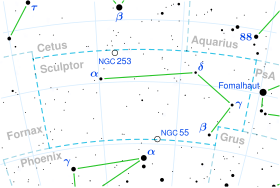Star in the constellation Sculptor
Theta Sculptoris
Location of θ Sculptoris (circled)
Observation dataEpoch J2000.0 Equinox J2000.0
Constellation
Sculptor
Right ascension 00h 11m 44.02079s [ 1]
Declination
−35° 07′ 59.2320″[ 1]
Apparent magnitude (V)± 0.005[ 2]
Characteristics
Evolutionary stage
main sequence
Spectral type
F5V[ 3]
B−V color index
± 0.002[ 4]
Astrometry Radial velocity (Rv )± 0.3[ 4] Proper motion (μ) RA: +171.529[ 1] mas /yr Dec.: +126.670[ 1] mas /yr Parallax (π)46.1936 ± 0.1565 mas [ 1] Distance 70.6 ± 0.2 ly pc ) Absolute magnitude (MV )3.52[ 2] Details[ 2] Mass 1.25 M ☉ Radius ± 0.05R ☉ Luminosity 3.09[ 4] L ☉ Surface gravity (log g )± 0.10cgs Temperature ± 80K Metallicity ± 0.07dex Rotational velocity (v sin i )± 1.0Age +2.4 [ 4] Gyr Other designations θ Scl ,
CD −35°4,
FK5 6,
GC 202,
GJ 3013,
HD 739,
HIP 950,
HR 35,
SAO 192388,
LTT 79,
GSC 06995-01262[ 5] Database references SIMBAD data
θ Sculptoris , Latinized as Theta Sculptoris , is a star in the southern constellation of Sculptor . This object is visible to the naked eye as a dim, yellow-white hued star with an apparent visual magnitude of +5.24.[ 2] light years from the Sun based on parallax .[ 1] radial velocity of −21 km/s, and may come to within 49 light-years in half a million years.[ 4]
According to Fuhrmann and Chini (2015) this is an astrometric binary system,[ 6] [ 7] F-type main-sequence star with a stellar classification of F5V.[ 3] [ 4] mass of the Sun and 1.40 times the Sun's radius . The star is radiating three[ 4] luminosity of the Sun from its photosphere at an effective temperature of 6,395 K.[ 2]
References
^ a b c d e f Brown, A. G. A. ; et al. (Gaia collaboration) (August 2018). "Gaia Data Release 2: Summary of the contents and survey properties" . Astronomy & Astrophysics 616 . A1. arXiv :1804.09365 Bibcode :2018A&A...616A...1G doi :10.1051/0004-6361/201833051 Gaia DR2 record for this source at VizieR .^ a b c d e Fuhrmann, K.; Chini, R. (2012), "Multiplicity among F-type Stars", The Astrophysical Journal Supplement , 203 (2): 20, Bibcode :2012ApJS..203...30F , doi :10.1088/0067-0049/203/2/30 ^ a b Gray, R. O.; Corbally, C. J.; Garrison, R. F.; McFadden, M. T.; Bubar, E. J.; McGahee, C. E.; O'Donoghue, A. A.; Knox, E. R. (2006), "Contributions to the Nearby Stars (NStars) Project: Spectroscopy of Stars Earlier than M0 within 40 pc--The Southern Sample", The Astronomical Journal , 132 (1): 161– 170, arXiv :astro-ph/0603770 Bibcode :2006AJ....132..161G , doi :10.1086/504637 , S2CID 119476992 . ^ a b c d e f g Anderson, E.; Francis, Ch. (2012), "XHIP: An extended hipparcos compilation", Astronomy Letters , 38 (5): 331, arXiv :1108.4971 Bibcode :2012AstL...38..331A , doi :10.1134/S1063773712050015 , S2CID 119257644 . ^ "tet Scl" . SIMBAD Centre de données astronomiques de Strasbourg . Retrieved 2019-09-03 .{{cite web }}: CS1 maint: postscript (link )^ Fuhrmann, K.; Chini, R. (August 2015), "Multiplicity among F-type stars. II", The Astrophysical Journal , 809 (1): 19, Bibcode :2015ApJ...809..107F , doi :10.1088/0004-637X/809/1/107 , 107. ^ Eggleton, P. P.; Tokovinin, A. A. (September 2008), "A catalogue of multiplicity among bright stellar systems", Monthly Notices of the Royal Astronomical Society 389 (2): 869– 879, arXiv :0806.2878 Bibcode :2008MNRAS.389..869E , doi :10.1111/j.1365-2966.2008.13596.x S2CID 14878976 .
